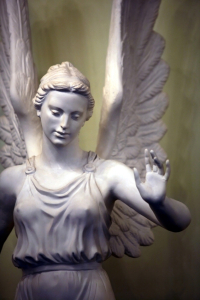Andrea Pflaumer's Blog, page 14
July 10, 2014
Know Your Neutrals: 50 Shades of Gray
 Salacious popular novels aside, gray, as a wardrobe staple, has gotten something of a bad rap. Some people consider it dull. In fact, it is a very elegant color. Wearing gray makes you appear dignified but not somber, pulled together but not haughty, and dependable but not boring. And, it’s having a fashion “moment” now.
Salacious popular novels aside, gray, as a wardrobe staple, has gotten something of a bad rap. Some people consider it dull. In fact, it is a very elegant color. Wearing gray makes you appear dignified but not somber, pulled together but not haughty, and dependable but not boring. And, it’s having a fashion “moment” now.
Because it’s a fairly neutral neutral most of us can wear a broad range of grays. As with all colors, stick with those that are most complimentary to your skin tone. Here are examples of a gray for each of the four pure color archetypes. (If you go to my Pinterest page on this subject you’ll see several more examples including garments that cross color archetypes.)
 Someone whose color palette is in the Bold or winter range would do well to look for grays that make a bold statement themselves. Their gray has to have enough excitement on its own because people with winter coloring need color contrast. Here is a beautiful one from Reed Krakoff’s 2014 2015 runway show. Not to gild this lily, she could add something in scarlet to make it really pop.
Someone whose color palette is in the Bold or winter range would do well to look for grays that make a bold statement themselves. Their gray has to have enough excitement on its own because people with winter coloring need color contrast. Here is a beautiful one from Reed Krakoff’s 2014 2015 runway show. Not to gild this lily, she could add something in scarlet to make it really pop.
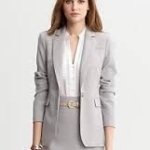 This suit from Banana Republic, is the kind of gray that works well on the Spring color archetype. It’s crisp, light, and bright. The first impression it gives is “freshness.” (That’s partly due to the fabric itself.) People with a lot of Bright in their palette tend to have brightness in their skin tone so they can make a more playful statement of this by combining it with a coral, or yellow, or possibly turquoise scarf or top.
This suit from Banana Republic, is the kind of gray that works well on the Spring color archetype. It’s crisp, light, and bright. The first impression it gives is “freshness.” (That’s partly due to the fabric itself.) People with a lot of Bright in their palette tend to have brightness in their skin tone so they can make a more playful statement of this by combining it with a coral, or yellow, or possibly turquoise scarf or top.
 Those with the gentle coloring of Subtle/Soft summer coloring would do well to make gray a primary wardrobe staple since most of their colors are, in fact, grayed. That makes it easy to create a pretty refined wardrobe. A suit in this pale, pearly gray color could be lovely paired with a delicate mauve, lilac, or peach sherbet blouse or scarf. Yummy! (I admit to Subtle/Soft envy…)
Those with the gentle coloring of Subtle/Soft summer coloring would do well to make gray a primary wardrobe staple since most of their colors are, in fact, grayed. That makes it easy to create a pretty refined wardrobe. A suit in this pale, pearly gray color could be lovely paired with a delicate mauve, lilac, or peach sherbet blouse or scarf. Yummy! (I admit to Subtle/Soft envy…)

Fall-type grays must have some warmth to them. Here’s one from a recent Ideeli Designer sale (don’t know the designer, sadly…) Even their charcoals, which are nice neutrals for them, have to have some hint of brown or yellow. This one is definitely not black. It’s definitely not light. It has depth and warmth. Now, imagine this worn with a plum or coral tee. Rich.
So those are just four examples for each of the seasonal archetypes. Because your own coloring is a likely combination of multiple seasons pay close attention to the amount of contrast you can wear and the amount of brightness or warmth in your own coloring. And don’t shy away from gray. It can, in fact, be kind of sexy!
 (Note: in my book, Shopping for the Real You I offer multiple “tests” to determine your own coloring and style types. For fine-tuning your palette I strongly recommend having a professional color consultation. My mentor, John Kitchener is currently offering a special on both color consultation and style analysis: check it out! )
(Note: in my book, Shopping for the Real You I offer multiple “tests” to determine your own coloring and style types. For fine-tuning your palette I strongly recommend having a professional color consultation. My mentor, John Kitchener is currently offering a special on both color consultation and style analysis: check it out! )
The post Know Your Neutrals: 50 Shades of Gray appeared first on Shopping for the Real You.
June 13, 2014
Shopping Heaven…and Hell
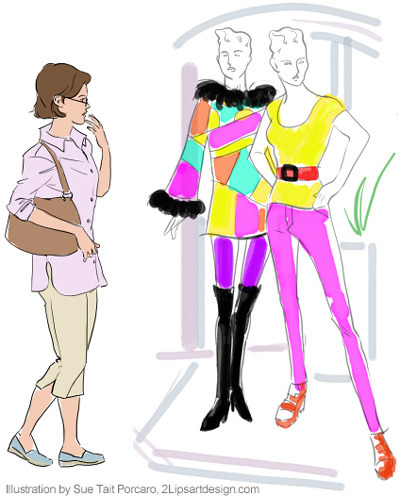 Does this scenario sound familiar? You wake up one morning full of enthusiasm and a sense that “today is a great day for a shopping trip.” You head off to the mall full of hope and expectation, only to spend fruitless hours of disillusionment and self-loathing… and end up at the ice cream shop instead.
Does this scenario sound familiar? You wake up one morning full of enthusiasm and a sense that “today is a great day for a shopping trip.” You head off to the mall full of hope and expectation, only to spend fruitless hours of disillusionment and self-loathing… and end up at the ice cream shop instead.
Don’t beat yourself up. We’ve all been there. Almost everyone has a hard time finding just the right item that is flattering in color and style. When something über stylish is all the rage but doesn’t suit you it can take will power to resist making a shopping mistake.
My goal is to help my readers discover and unfold the “gestalt” – the unique totality of who they are – through their color palette, personality, body shape and bone structure. In the opening chapters of Shopping for the Real You I explain the seven primary style archetypes, as codified in the Personal Style Counselors system. I also show four very basic color fans for the seasonal harmonies. And then I give examples and methods to determine your own palette and style type(s). (Although I strongly recommend getting professional help to fine tune your palette.)
On my Pinterest page you’ll find boards for each style type and each color harmony, along with some descriptions of why they fit into a particular category. I’ll also be adding boards for things like LBD’s for the different style types and for outfits that successfully combine style types. All that can add to your knowledge about your own style and coloring.
But even with all this information, don’t make yourself crazy looking for perfection when you shop. If you find it – rejoice! And there are fixes for those times when something is almost right, and clues to help you make better decisions overall. Here are a couple:
1) If the color is fantastic on you and the style is not yours but is more classic than super trendy, it will very likely still work for you. You can make it move closer to your style with accessories.
2) And if the style is perfect and the color is just a little off, you can adjust your makeup to make the garment work.
So the next time you have that intuitive feeling about a good shopping trip, be kind to yourself. Understand the pitfalls, but get familiar with the parameters of your unique coloring. Understand how your features, body shape and personality determine your style. And then apply that knowledge. You may not always find the perfect item, but you’ll likely find a better one than what’s all the rage. And, you’ll likely save money, headaches, and closet space.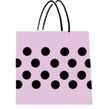
Here’s to the real you!
The post Shopping Heaven…and Hell appeared first on Shopping for the Real You.
April 30, 2014
Angels Among Us
In chapter three of Shopping for the Real You I offer four methods to help you determine your individual style, based on seven basic archetypes. The amount of each archetype that is expressed in your personality, facial features, and body type creates an overall picture of your unique style.
One of the more interesting and unusual of these archetypes is the Ethereal/Angelic type. The other six archetypes were delineated more than 60 years ago by Grace Margaret Morton, head of the Textiles and Clothing Department of the University of Nebraska. But it was John Kitchener of Personal Style Counselors – my mentor and the current Director of PSC – who identified and codified the Angelic style archetype in the 1980s.
For quite a while John was concerned that some of PSC clients whose features expressed the most extreme Yin qualities were simply grouped into the Youthful/Playful category. He felt that the descriptions for the Youthful/Playful type didn’t do justice to their specific features. After years of observation and research, he outlined a new style category, or “essence,” as he describes them, and gave it the name “Angelic.” He placed the Angelic style type on the opposite end of the spectrum from the very Yang Dramatic/Theatrical archetype. In a recent conversation John told me about how it all came into focus.
“I kept uncovering an imbalance in the PSC system,” John explained. “Joan (Songer, founder of PSC) and Ron (Sackman, previous PSC director) were fine with the way the six style Essences worked. But the Angelic idea had been percolating inside me for some time. It wasn’t until I was on leave from PSC in Washington, DC – from 1987 to 1989 – that the Angelic Essence seemed like a reality. During that time the designer Romeo Gigli was introducing ethereal-looking garments in layered chiffons that would later inspire works – even to this day – by Vera Wang and Eileen Fisher. When I layered these designs onto certain Angelic style types such as Vanessa Redgrave and the new Angelic style essence gelled easily.”
And thus was born the seventh style type: Angelic. It was a very important addition to the PSC style analysis system and created a beautiful symmetry: Three yang types, three yin types, and Classic in the middle.
What makes the Angelic types interesting is that in their waif-like qualities they present their own kind of drama – you can’t look away from them. They are uniquely mesmerizing. But if you spoke with a quintessential Angelic type you’d probably learn that being mesmerizing is something they don’t care to be. They are, after all – rather unearthly.
John describes three quintessential contemporary angelic types in the public eye: Darryl Hannah, Tilda Swinton and recent Oscar winner, Cate Blanchett. Let’s take a look at Darryl Hannah as an example of this type. Ms. Hannah, actress and ardent environmentalist, is tall and sensuous (which means she does, in fact have some Dramatic and Romantic) but her overall persona is more like the mermaid she played in Splash – fragile, vulnerable, and other-worldly. It was recently revealed that as a child she was diagnosed on the autism spectrum. All that adds up to describe an individual who is not as grounded in the fast-paced Western world as more yang types.
Such an archetype would most likely look and feel out of place wearing something in a wildly bold, dramatic pattern, or a stiff suit, or funky overalls, or a heavy black coat – except, of course, on the runway. (I’ve seen Angelics wearing those kinds of garments and I don’t think they bring out their best qualities.) Many models have a good punch of “Angelic” in their style. Their very malleability makes them perfect for the runway as they seem to get out of the way of the clothes they are wearing.
But generallyt it’s something of a challenge for the very pure Angelic types to find themselves reflected in popular fashion because as an archetype, they are somewhat rare. Designers make a living, after all, by creating fashion for as many customers as possible, not for the rare. (Largely the reason I wrote this book!)
Those who have a good deal of the Angelic/Ethereal style type certainly don’t always have to wear floating, diaphanous or sparkling fabrics and styles, but at least some part of their ensemble should be soft, shimmer or move gently. If you have a significant percentage of Angelic/Ethereal in your own features and personality, you may find that you already have incorporated many of those elements in your wardrobe. If you haven’t, give them a try. You’ll probably have an “aha” moment.
When I had my own style analyzed by John he explained that I have about 5% of the Angelic/Ethereal style type. Everything else in my features, coloring, and style is pretty much evenly distributed between the Natural/Relaxed, Classical/Traditional and Spirited/Exuberant style Essences.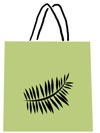
“How can I translate that little amount of Angelic into my wardrobe?” I asked John.
“Shoelaces,” he laughed.
April 10, 2014
Congratulations winners!
Thank you ALL for your interest in Shopping for the Real You. I think it strikes a chord out there - everyone wants the basic tools to develop a better wardrobe, and that's what I set out to accomplish: a primer on the eye-training tools and basics of shopping and dressing that will make your life easier and your shopping more fulfilling.
Thanks again and here's to the Real You! All of you!
March 6, 2014
You are What (make-up) You Eat
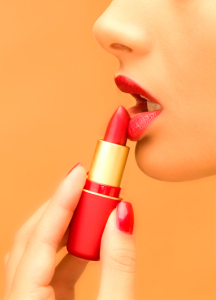 Last year there was a fair amount of media buzz around the shocking claim that the average woman (I’m still trying to figure out just who the proverbial “average” woman is) eats around six pounds of lipstick in a lifetime. But a few brainiacs did the math and discovered that the claim was wildly exaggerated. Still, around the same time there were a couple of real studies published that described unacceptable levels of toxic chemicals found in many of our cosmetics. Suddenly that lipstick-eating story got a lot of attention again.
Last year there was a fair amount of media buzz around the shocking claim that the average woman (I’m still trying to figure out just who the proverbial “average” woman is) eats around six pounds of lipstick in a lifetime. But a few brainiacs did the math and discovered that the claim was wildly exaggerated. Still, around the same time there were a couple of real studies published that described unacceptable levels of toxic chemicals found in many of our cosmetics. Suddenly that lipstick-eating story got a lot of attention again.
Any amount of lipstick we eat can’t be good if it contains toxic chemical and measurable amounts of lead, cadmium and arsenic — heavy metals and additives that end up lodged in our kidneys, liver and tissues. Additionally, since the skin is the largest organ in our bodies it becomes the first line of defense against, and unfortunately absorption of, a lot of these additives, whether we eat them or not. In Shopping for the Real You I mention these facts and encourage my readers to seek out the safest cosmetics they can find. The field of natural cosmetics and skin care is a huge and rapidly growing industry as more and more women begin to demand “cleaner” cosmetics.
Periodically I discover make-up and skin-care companies whose products are manufactured without toxic chemicals. I will be featuring some that I believe are going the extra mile to make sure what we put on our faces and skin makes us more beautiful and healthy-looking rather than sets us up for health problems down the road.
This month I’m delighted to feature Zosimos Botanicals. Named for the 4th Century Alchemist, Zosimos was founded by Lisa Stein, a mother and former trademark attorney who decided to opt for a more serene, eco-friendly life. Her company’s mission is to create a business that supports a healthy environment and to produce products that support a healthier customer. And her products are never animal tested. (Yay!) In addition to the values reflected in the manufacture of her products, you’ll see that the lipsticks, eyeliners, etc. are just plain pretty! She also carries a huge selection of natural skin care products.
Zosimos has also helped to solve one of the economic frustrations a lot of us experience, namely that we buy a lipstick that looks good in the store but not so great when we get home — and we’ve just spent $20 on it. If you find a yummy-colored Zosimos lipstick that seems to be right for your coloring, you can try it out in one of their $5 mini size versions first. At that price you can buy multiple trial sizes (I did and love every one of them.) And they have refills of many of their products. As I said — it’s a true eco-friendly company. I have great respect for what Linda has done, and I’m very happy to recommend Zosimos to my readers.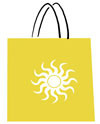
So here is a coupon code for 10% off Zosimos products, good through the end of March, 2014: shopbeauty
And here is the link to the site: www.zosimosbotanicals.com
Here’s to happy — and healthier — shopping.
February 7, 2014
Your Uniform
 My hairdresser, a very handsome young man, wears the same attire every day: a black Hanes t-shirt, black jeans that are cut off just above the knee, black socks and black leather high top boots. Any skin surface that does show is covered with some colorful and pretty magnificent tattoos.
My hairdresser, a very handsome young man, wears the same attire every day: a black Hanes t-shirt, black jeans that are cut off just above the knee, black socks and black leather high top boots. Any skin surface that does show is covered with some colorful and pretty magnificent tattoos.
Now, you’d think that he just throws on what he was wearing the day before, but no. This is an extremely well thought-out uniform. He directs the same perfectionist’s critical eye to his attire that he does to each hair on each head of hair he cuts. He orders Hanes t-shirts by the package of three and tries on each one to make sure they’re cut exactly right. As is sometimes the case, one will be slightly off, and back it goes to the factory. Regarding the jeans, he has his artfully cut off and then tailored exactly to fit his body by a not-inexpensive European tailor.
This young man is supremely comfortable in himself and his style and has honed that style to an art. I envy him. I can’t see myself going to the same extreme with my own wardrobe, but I’m more and more leaning in that general direction: find something that works and repeat it.
In Shopping for the Real You I talk about uniforms and why they make our lives less stressful. If you have something that works for you, you don’t have to reinvent yourself every time you get dressed. So here are a few ideas about how to find and work with your own uniform. If you’re just uninterested in the entire concept of uniforms, think about these in the way you might think of a go-to recipe when company is suddenly coming over – simple things you know will turn out well.
1) Pick a few classics that work for your body and wear them repeatedly, changing out a different blouse, jacket or a statement piece of jewelry or accessory.
2) The reverse of that: Find a great piece of jewelry or a scarf or a terrific outerwear coat or jacket and make that the “statement” of your uniform. (And, best worn with more simple classics.)
3) One of my favorite memes: If the shoe fits, buy it in every color. If you find something that works for you in cut and style but you get bored wearing the same thing every day, buy the new item in different colors, if it’s available in different colors. Just make sure they’re YOUR colors.
4) When you put together outfits that work for different kinds of occasions, hang the pieces together in your closet to grab when you need to dress for those occasions.
5) Finally, if you have to wear an actual uniform and it is completely the wrong color or style for you, tart up your make-up a bit, wear sparkly earrings and most of all – your beautiful, warm smile – the very best ‘uniform’ money can’t buy.
Post script: Be sure to take photos of combinations that work for you. It’s hard to trust your memory when a closet full of clothes is staring back at you.
January 14, 2014
Mirror Exercise
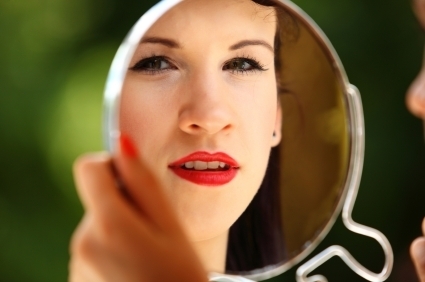 Here’s an exercise I do while leafing through magazines and catalogs to see what’s new in the stores and what might work in my own wardrobe. It helps me avoid impulse buys that can end up hanging in my closet unworn because they don’t go with anything else.
Here’s an exercise I do while leafing through magazines and catalogs to see what’s new in the stores and what might work in my own wardrobe. It helps me avoid impulse buys that can end up hanging in my closet unworn because they don’t go with anything else.
This is how it works: If I see something I like, I look at it for a minute – keeping in mind the color, cut, trim details and proportions. Then, I look at myself in the mirror. Then I look back at the image in the catalog or magazine. And then, back in the mirror. If the item works for me, instantly I feel a sense of harmony — of balance – “yeah – that’s me.” If it doesn’t work there’s an immediate “disconnect” — something I feel almost viscerally. (This reinforces my comments in the book about why it’s valuable to educate yourself to the point where you can trust your gut instinct.)
If the garment meets all my criteria and it’s not a sale item that might be sold out quickly I mark the page and revisit it a couple of days later. In the meantime, I check out my closet to see if I have something like it already that can be made to look fashion-forward. (Sometimes we’re attracted to an item in a catalog or magazine because we already have something very much like it.)
Taking inspiration from those images in magazines and catalogs, I often find that all I need to do to freshen up an old favorite is to find a new accessory: maybe a piece of jewelry, different shoes or a scarf in a color that’s popular and that is within my personal color palette. Or maybe my old favorite can be worn with something different than what I’ve typically worn it with, such as a different outerwear piece, blazer or sweater. Sometimes simply combining colors I hadn’t thought about before can really bring an old standard fashion-forward.
 If after “shopping in my own closet” I still think the new piece would be a great and indispensable addition to my wardrobe, I buy it. Guilt free.
If after “shopping in my own closet” I still think the new piece would be a great and indispensable addition to my wardrobe, I buy it. Guilt free.
Next time you see something you can’t live without, give this a try. Having an understanding of your own style type(s) and a general grasp of the colors that are most flattering on you can make this process a lot of fun — and, it can save you time and money.
November 9, 2013
Color and First Impressions
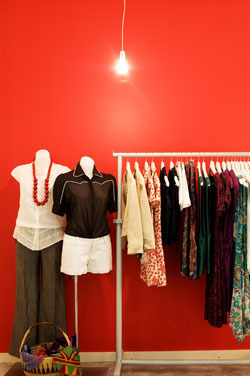
You want to stay true to yourself in fashion, particularly when it comes to your colors. But sometimes you just gotta break—or temporarily bend—the rules a bit. Here’s an example.
Many years ago a woman I know had an important business meeting with a group of potential investors for a TV series she was pitching. They were known to be extremely hard bargainers, notoriously sexist and profoundly stingy. She found out ahead of time that everyone in their executive office, particularly during negotiations, dressed in white. It set their ‘tone’ as being members of a lofty pantheon of power and authority. She wore white that day. She got the sale. (Hopefully she was wearing her version of white…)
Knowing the culture of your potential client/employer or partner is an important part of establishing equal footing with and gaining respect from them. In the above example, the power of color was a significant subliminal component that helped make a positive first impression.
The colors you wear can contribute to your success or failure in any negotiation or meeting, whether it’s a first date or a major business deal. Since—most of the time—you’re going to be wearing your true colors, here’s a little excerpt from the Shopping for the Real You Chapter about Working With Your Colors about the psychological effects of the primary colors—red, blue and yellow:
Reds are romantic. They stimulate. Red is the color of hemoglobin (literally life’s blood), vitality, sensuality, and danger. Wearing anything in the red family telegraphs these qualities, so make sure you really want to make a red statement when you wear it. For those who are not particularly romantic in their style type (which we will discuss in Chapter 3) wearing the reds in their palette can make them appear more romantic. In fact, the less romantic quality in someone’s personal style, the more they can get away with a lot of red without looking tart-y.
Reds that are tinted with white or light yellow—including pinks, salmon, and peach—can make someone seem younger. Everyone has some of the lighter reds in their palette and these are useful when you want to appear more approachable and lighthearted. Reds tempered with black, like burgundy or maroon, create an impression of dignity and maturity. Corals—red combined with yellow—express health and freshness. Reds combined with brown take on a rich, earthy quality and make someone appear grounded.
Blues are always considered cool colors. Those with warmer color markers will find less saturated and more teal shades of blue in their palettes. Extremely versatile, blues have the ability to express the full range of emotions from power and drama to calmness and serenity. Although people think of red as the most powerful color, my own color guru, John Kitchener (director of Personal Style Counselors), says that in fact blues—and some of the more saturated greens in your palette—are your true power colors. They express that power in a more subtle manner. Rich, saturated blues suggest authority and credibility. We wear blue when we want to be taken seriously or exert influence. Softer blues can make us feel relaxed and hopeful.
When toned down with black, creating the range of navy shades from indigo to what is called dark rinse in jeans, blues convey conservatism. Or, as with the blue jeans example, they become the great equalizer—a safe color for the masses. Blues washed with white are lively and crisp and suggest clarity of mind and spirit. Aqua—pale greenish blue—bestows peace on the viewer and the environment.
Yellows are some of the most intriguing and complex colors. They are the only ones that are limited for some people because certain yellows can turn some skin tones sallow. Depending on where you live in the world, the color yellow has wildly diverse implications; it represents commerce in India, courage in Japan, and mourning in Egypt. But in the West, yellows are considered to be jubilant. That’s likely because they imply the liveliness and joy of the sun—the giver of life. They add spice, energy, and warmth to anything they’re worn with. In nature yellow flowers speak of optimism and good cheer. In their unique and playful way, yellows makes a pretty bold color statement, especially in a workplace or social milieu that favors a kind of uniform of neutrals or dark colors.
Yellows can be youthful and also versatile when combined with other colors. When toned down with black, they turn earthy, rich, and grounding; when lightened with white, they’re positively angelic and airborne! Yellow grabs our attention: When contrasted with black, as in street signs, it says, Caution! But in mineral form yellow becomes golden—appearing warm, rich, and rare.
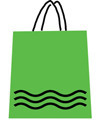 One last note: When looking at a color to see if it works for you, keep in mind that there is a vast range of shades within one color family and that they can vary profoundly and produce profoundly different effects. A specific shade of red may appear powerful on one person and tart-y on another. Also, depending on your basic coloring (skin tone, eye and hair color) a color that looks cheerful on the hanger may make you look sickly in the mirror. Always look at yourself carefully in natural light before buying a garment and make sure the color conveys what you intend to convey when you wear it.
One last note: When looking at a color to see if it works for you, keep in mind that there is a vast range of shades within one color family and that they can vary profoundly and produce profoundly different effects. A specific shade of red may appear powerful on one person and tart-y on another. Also, depending on your basic coloring (skin tone, eye and hair color) a color that looks cheerful on the hanger may make you look sickly in the mirror. Always look at yourself carefully in natural light before buying a garment and make sure the color conveys what you intend to convey when you wear it.
Fashion Week—Every Week
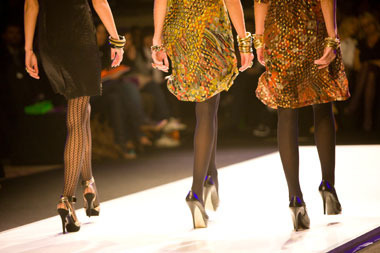 While packing for a trip to New York for my niece’s wedding, which just so happened to coincide with Fashion Week, I read the following amusing (sort of) quote on designer Mondo Guerra’s Facebook page: “Every year women in New York City put the past behind them and look toward the future: it’s called Fashion Week.”
While packing for a trip to New York for my niece’s wedding, which just so happened to coincide with Fashion Week, I read the following amusing (sort of) quote on designer Mondo Guerra’s Facebook page: “Every year women in New York City put the past behind them and look toward the future: it’s called Fashion Week.”
I’m sure that’s a delightful concept for designers and retailers who make a living by inspiring some level of insecurity in their customers: “If I don’t buy the latest I’ll be so passé.” Now, I love buying something new every season as much as anyone, but the idea that what looked terrific just last year is now horribly out of date is, IMHO, retail tyranny.
Of course, if you buy something that is so exaggerated in color, pattern or cut that it has about a three-month shelf life you can expect it to be out of style pretty quickly. (And by the way, when you see those starlets and models in “candid” shots in magazines wearing those very outré pieces you can bet they were given to them by the designers’ publicists.)
So what did I pack for September in New York? A pair of stretchy dark brown tailored “track pants” that went from day to night effortlessly which I wore with an extremely comfortable pair of cream and black stretchy sandals. I wore the pants with a couple of blouses—one silk, one yellow cotton and a brown/tan striped tee. For the evening, an off-white knit sweater/coat with the pants. I found an amazing a cream and black playful geometric print sundress (at a local ‘seconds’ shop for $13.99!) that I wore with a coral knit sweater. For the wedding: a silk light taupe/dark taupe print dress with a skin colored pair of off-white low heeled “snakeskin” pumps. They all had the right tailored but light-hearted flavor of my style types, (Classic/Traditional, Exuberant/High Spirited and Natural/Relaxed) and were just trendy enough for the bright lights of the Big Apple.
Only four of the items were new things I had bought this year.
If you know your color and style and the basic principles of proportion, balance and scale you should expect what you buy to be wearable, flattering and chic-looking for a long time. Just keepin’ it real, here’s to the real you!
Why the classic wardrobe pieces have something for everyone
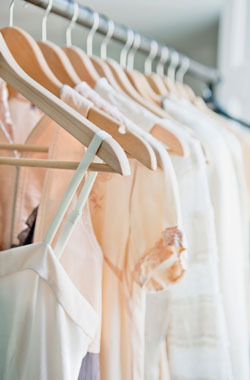 In the book I describe some of what are considered the classic wardrobe staples that every woman should own. I always have to qualify this concept with a little dose of reality and this caveat: depending upon your lifestyle and coloring, the strictly “classic” version of these may not work for you.
In the book I describe some of what are considered the classic wardrobe staples that every woman should own. I always have to qualify this concept with a little dose of reality and this caveat: depending upon your lifestyle and coloring, the strictly “classic” version of these may not work for you.
Still, they have stood the test of time (at least for the past 100 years or so—in the larger scheme of things these too may pass) for a reason. Here are some of the reasons why classics are sexy and appropriate for more than just the Classic/Traditional style type.
Everybody’s de rigueur white cotton blouse has a Romantic/Alluring silhouette because the v-neck draws the eye to, and suggests the existence of, cleavage, so it can add a little sexiness to any outfit. It also carries some feeling of Youthful/Playfulness because of its crisp, fresh fabric texture. And because it’s uncomplicated it appeals to the Natural/Relaxed types who don’t like to spend a lot of time getting dressed.
A trench coat creates a sense of mystery. By covering up what you are wearing with a garment that suggest menswear it implies you are on as secret mission or are trying to hide something—something that appeals to both a Dramatic/Theatrical style type and in its mystery, even the Angelic/Ethereal type. It’s also appealing to a variety of style types in that wearing anything in a fabric or cut typically used for menswear plays against type similarly to the way a boyfriend jacket or wearing an actual boyfriend’s shirt is sexy.
Leopard—and any animal print for that matter—is one of the most specific reflections of nature that we can wear and it works on a broad range of different types for different reasons. It speaks directly to the Natural/Relaxed type but in a tongue-and-cheek way because you aren’t wearing the actual animal—at least I hope not. (I personally am averse to buying fur. With so many convincing faux fur fabrics these days killing an animal just to look sexy, mysterious and powerful is, IMHO, beyond unnecessary.) Because it’s a kind of “wink-wink” pattern, animal prints become Spirited/Exuberant too. And because it suggests you have conquered such a “dangerous” beast it is also Dramatic/Theatrical. In another way, it becomes somewhat Romantic/Alluring. Men traditionally have been associated with hunting, so the women who wear animal prints become as if the Romantic/Alluring hunted. (Yeah, I know that one’s pretty creepy, sexist and is going to get me in hot water, but still…)
Things like Topsiders, sneakers and LLBean totes are quintessentially Natural/Relaxed and Classical/Traditional at the same time and immediately say “preppy chic.” The typical colors and fabrics of these items make you think of summertime, a season associated with Youthful/Playful good times and outdoor get-togethers that appeal to every type, but particularly the Natural/Relaxed types.
The LBD is Dramatic (simply because of its color) and Romantic (because of its often body-skimming silhouettes). The starkness of black also suggests something “beyond” or hidden and that alone increases the drama. And even those waif-like Angelic/Ethereal types can identify with the otherworldliness of something hidden or beyond. Always, when choosing one of the classic pieces, make sure the color, fabric and drape are complimentary to your coloring, style type and body.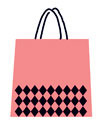
And then, of course, there’s the fact that the Classic/Traditional style type is the balance point between all the other six types that we talk about in the book. It’s just practical and comforting to know that you can grab one of the classic pieces out of your closet and that you will look pulled together.

